Toothed whales (Odontocetes) are the secret agents of the ocean. They are always on the move and evading capture by researchers and biologists who want to learn more about them. These marine mammals are masters of disguise, blending in with their surroundings and disappearing into the depths at a moment’s notice. Trying to track them down is like trying to find a needle in a haystack – if the needle could swim at lightning speed and hold its breath for an hour. But despite their elusive nature, we’ve managed to uncover some fascinating facts about these mysterious creatures. In addition, the more we learn, the more we’re drawn into the underwater world of intrigue and adventure of toothed whales.

These marine mammals are masters of disguise, blending in with their surroundings and disappearing into the depths at a moment’s notice. This Cuvier’s beaked whale can reach depths of nearly 10,000 feet (3 km).
©iStock.com/HeitiPaves
Toothed whales are a fascinating group of creatures that have captured the imaginations of scientists and also novelists alike. Whether you’re interested in their unique communication abilities, their hunting prowess, or just their adorable faces, there’s no denying that Odontocetes are a compelling subject to sink your teeth into. So let’s plunge into the depths of their watery world and discover what makes these sleek and intelligent creatures so captivating.

Whether you’re interested in their unique communication abilities or their adorable faces, there’s no denying that
Odontocetesare a compelling subject! Sperm whale (
Physeter macrocephalus)
©Animalgraphy/Shutterstock.com
Disambiguation
Cetacea, a group of aquatic mammals that includes whales, dolphins, and porpoises, is divided into two suborders: toothed whales (Odontocetes) and baleen whales (Mysticeti). Toothed whales have teeth and feed on fish and squid. Baleen whales have baleen plates and filter small creatures like krill from the water. Dolphins and porpoises are classified as toothed whales. In addition, the killer whale (Orcinus orca) is classified as a dolphin! And a toothed whale. In total Cetacea contains over 90 species across numerous genera. For the sake of practicality, the infraorder Cetacea has been divided into three separate articles. To read about every species of baleen whale in the world go here. Click here if it’s dolphins and porpoises you wish to dive into. And if you’re interested in learning about every species of toothed whale, including beluga whales and sperm whales, keep reading!

Orcas, or killer whales (Orcinus orca), are classified as
dolphins
!
©slowmotiongli/Shutterstock.com
Odontocetes
The name Odontocetes comes from the Greek words odonto meaning tooth and ketos meaning sea monster. Therefore, Odontocetes means toothed sea monster. While whales are generally known for their peaceful behavior, they are also enormous, powerful, and potentially dangerous wild animals. Whales have, however, demonstrated remarkable intelligence and empathy. They have been known to exhibit curiosity and also playful behavior around humans. So while their name suggests that they’re monsters, they’re just monstrously large.

Whales have demonstrated remarkable intelligence and empathy, and have also been known to exhibit curiosity and even playful behavior around humans. Beluga whale
(Delphinapterus leucas)and calf.
©CampCrazy Photography/Shutterstock.com
There are 10 families of toothed whales (9 extant; 1 extinct) contained in the suborder Odontocetes:
- Physeteridae – The sperm whale family
- Kogiidae – The pygmy and dwarf sperm whale family
- Ziphidae – The beaked whale family
- Monodontidae – The beluga and narwhal family
- Delphinidae – The oceanic dolphin family
- Iniidae – The Amazon river dolphin family
- Platanistidae – The river dolphin family
- Pontoporiidae – The La Plata dolphin family
- Phocoenidae – The porpoise family
- Lipotidae – The Baiji or Chinese river dolphin family (although this family is now considered functionally extinct)
This article will focus exclusively on Ziphidae, Physeteridae, Kogiidae, and Monodontidae. For all other families (dolphins and porpoises) click here.
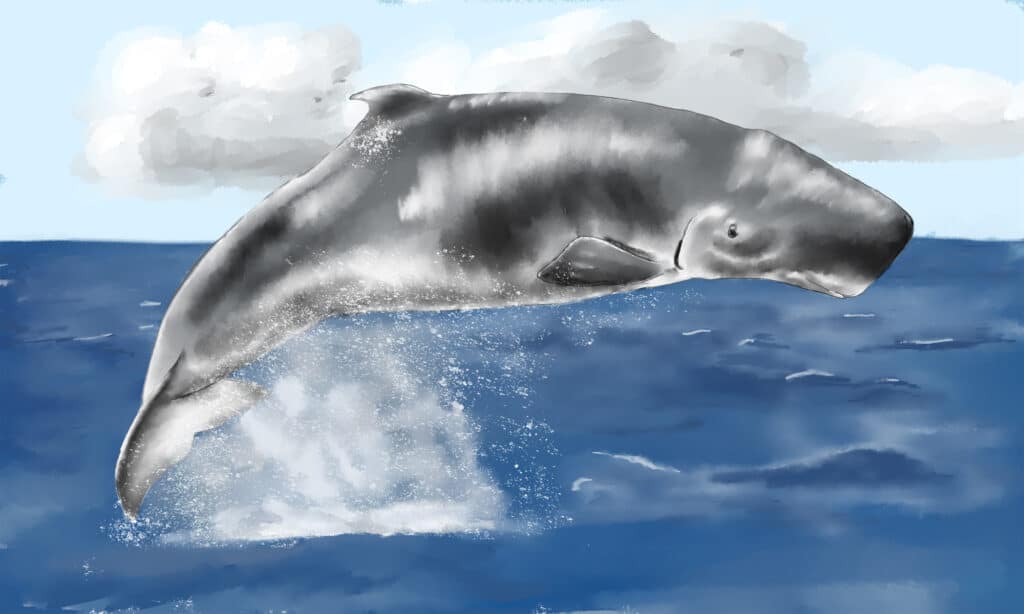
Toothed Whales: Teeth
Toothed whales have a variety of teeth adapted to suit their unique hunting habits. Odontocetes use their teeth to capture and devour prey, including fish, squid, and other marine animals. The number, size, and shape of teeth vary depending on the species and also their diet. Beluga whales have 30-40 teeth conical teeth, while sperm whales, have 34-58 teeth, all of them in the lower jaw! The teeth of some species, such as the narwhal (Monodon monoceros), are unique and may be used for specialized purposes or for social displays.
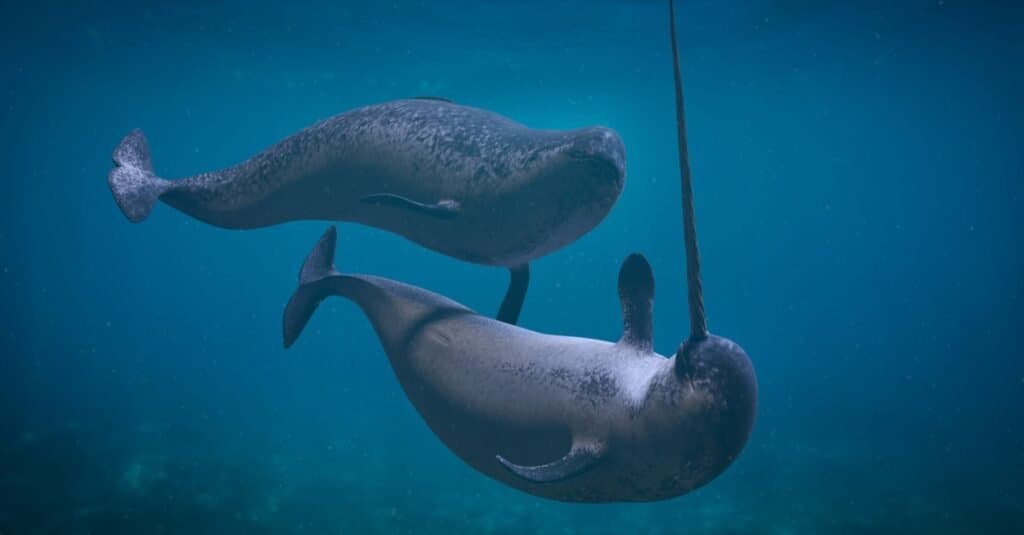
The teeth of some species, such as the narwhal (
Monodon monoceros), are unique and may be used for specialized purposes or for social displays.
©iStock.com/dottedhippo
Toothed whales’ teeth are made of a hard, durable material called dentin. Dentin is a dense, bony material that makes up the majority of the tooth structure in toothed whales. In addition, the dentin is protected by an outer layer of enamel, which is only present on the tips of the tooth and wears away quickly as the tooth is used for grasping and holding onto prey. Dentin is found in the teeth of all mammals, including whales,
Scrimshaw
Scrimshaw is a traditional folk art form that involves carving or etching designs onto whale teeth or bones. The art form is closely associated with whaling, as sailors on long whaling voyages would often pass the time by creating intricate designs on whale teeth that they had collected.
Historically, scrimshaw was created by using a sharp tool to carve designs into the surface of a whale tooth. The designs often depicted nautical themes, such as ships, whales, and mermaids. The carved designs were then filled with ink.

The designs often depicted nautical themes, such as ships, whales, and also mermaids.
©Lynn Watson/Shutterstock.com
Toothed Whale Families and Species
While all dolphins and porpoises are considered toothed whales, not all toothed whales are classified as dolphins and porpoises. As previously mentioned this article’s focus is on the toothed whales that are not also classified as dolphins or porpoises. The four families that contain non-dolphin/porpoise-toothed whales are Ziphidae, Physeteridae, Kogiidae, and also Monodontidae.
Common characteristics of these families include:
- Teeth: As their name suggests, true-toothed whales have teeth rather than baleen plates for filtering food. They have a variety of tooth shapes and sizes, depending on their diet and feeding behavior.
- Echolocation: Most odontocetes use echolocation to locate prey and navigate their environment. They produce high-frequency clicks or whistles and use the echoes that bounce back to create a sonic picture of their surroundings. All species of toothed whales have a melon, a mass of adipose tissue in their foreheads that focuses and modulates the animal’s vocalizations and acts as a sound lens.
- Social behavior: Toothed whales are highly social animals and often live in groups, called pods. They use vocalizations and body language to communicate with each other and coordinate their activities.
- Blubber: These whales have a thick layer of blubber under their skin. The blubber provides insulation and also energy storage for long migrations and dives.
- Large brain: Odontocetes have large brains relative to their body size, which is thought to be related to their advanced social behavior, communication, and problem-solving abilities. They are considered by many to be the smartest creatures in the world.
- Global distribution: True-toothed whales are found in oceans all around the world, from the Arctic to the Antarctic, and also from shallow coastal waters to the deep open ocean.
Ziphidae: The Beaked Whales
There are presently (2023) approximately 23 species of beaked whales (Ziphidae) contained in six genera. These mammals have a distinctive long, narrow beak-like snout. They have multiple sets of teeth in both their upper and lower jaws, and they are known for their deep-diving behavior. Some species of beaked whales can dive to depths of nearly 10,000 feet (3 km) and stay underwater for over an hour. Beaked whales are found in all of the world’s oceans, but they are typically found in deep offshore waters. The largest species of beaked whale is Baird’s beaked whale (Berardius bairdii), which grows to be 36 feet (11 m) and weighs as much as 26,455 pounds (12 metric tons).

Beaked whales are named for their distinctive beak-shaped snouts, which are longer and more pointed than those of other toothed whales. Pictured: True’s beaked whale (Mesoplodon mirus).
Key Characteristics of Beaked Whales (Ziphidae)
Whales belonging to the family Ziphidae have the following traits:
- Beak-shaped snout: Beaked whales are named for their distinctive beak-shaped snouts, which are longer and more pointed than those of other toothed whales.
- Dentition: Most species of beaked whales have only two teeth in their lower jaw, which are often not visible from the outside. In some species, the males have larger, more prominent teeth that are used for fighting and mating.
- Feeding behavior: Beaked whales are known for their deep diving and unique feeding behavior. They primarily feed on deep-water squid and fish and are also thought to use echolocation to locate their prey in the darkness of the deep ocean.
- Social behavior: Beaked whales are highly social animals that live in groups called pods. These pods may range in size from just a few individuals to more than 20.
- Distribution: Beaked whales are found in all of the world’s oceans, but are most commonly found in deep offshore waters. Some species are more widely distributed than others, and certain species are known to migrate between different regions.
- Elusive nature: Beaked whales are notoriously difficult to study, as they spend much of their time in deep waters far from shore. This has led to many gaps in the knowledge of these animals, including their behavior, vocalizations, and population sizes. Some species of beaked whales have never even been seen by humans while still living. Records of these species are compiled from beached (dead) whales. The species Perrin’s beaked whale (Mesoplodon perrini), for example, was identified through genetic analysis of carcasses. Sato’s beaked whale (Berardius minimus) was hypothesized and classified for years before actual sightings in 2021.

List of Beaked Whales (Ziphidae)
Genus Berardius
- Arnoux’s beaked whale (Berardius arnuxii) aka New Zealand beaked whale, Southern beaked whale, Southern four-toothed whale, Southern giant bottlenose whale, and Southern porpoise whale
- Baird’s beaked whale (Berardius bairdii) aka giant four-toothed whale, Northern four-toothed whale, Northern giant bottlenose whale, North Pacific bottlenose whale, and North Pacific four-toothed whale
- Sato’s beaked whale (Berardius minimus)
Genus Hyperoodon
- Northern bottlenose whale (Hyperoodon ampullatus)
- Southern bottlenose whale (Hyperoodon planifrons)
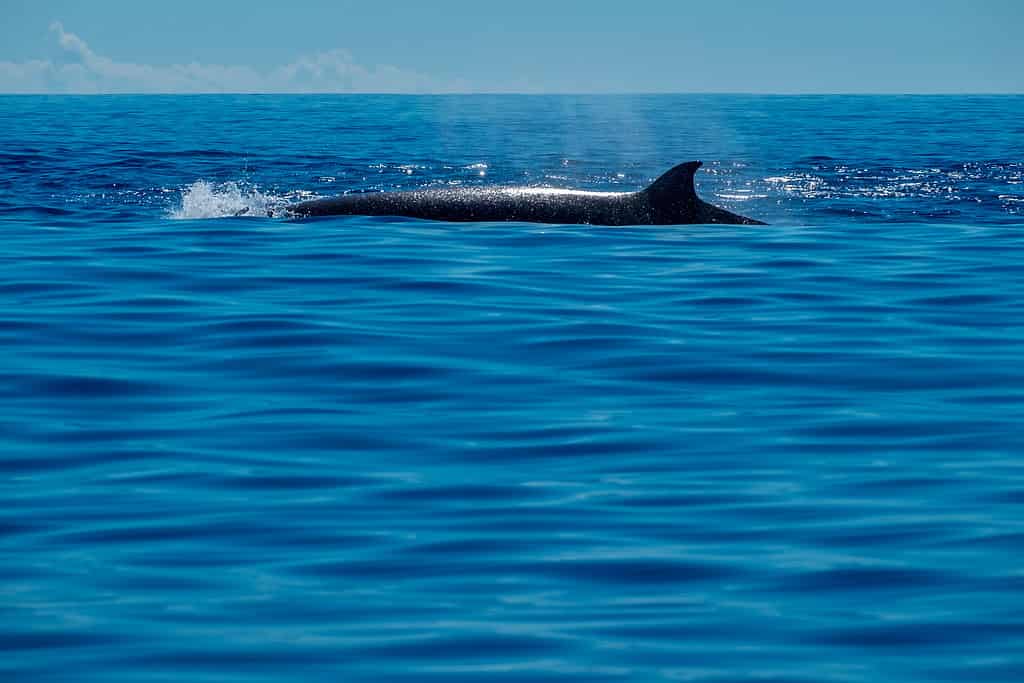
A Northern bottlenose whale (
Hyperoodon ampullatus) surfacing in the ocean.
©Wild_and_free_naturephoto/Shutterstock.com
Genus Indopacetus
- Longman’s beaked whale (Indopacetus pacificus) aka tropical bottlenose whale, Indo-Pacific beaked whale
Genus Mesoplodon
- Andrews’ beaked whale (Mesoplodon bowdoini) aka deep-crest beaked whale or splay-toothed whale
- Blainville’s beaked whale (Mesoplodon densirostris) aka dense-beaked whale,
- Deraniyagala’s beaked whale (Mesoplodon hotaula)
- Gervais’ beaked whale (Mesoplodon europaeus) aka Antillean beaked whale, Gulf Stream beaked whale, or European beaked whale
- Ginkgo-toothed beaked whale (Mesoplodon ginkgodens)
- Gray’s beaked whale (Mesoplodon grayi) aka Haast’s beaked whale, scamperdown whale, or Southern beaked whale
- Hector’s beaked whale (Mesoplodon hectori)
- Hubb’s beaked whale (Mesoplodon carlhubbsi)
- Layard’s beaked whale (Mesoplodon layardii) aka strap-toothed beaked whale
- Spade-toothed whale (Mesoplodon traversii)
- True’s beaked whale (Mesoplodon mirus)
- Pygmy beaked whale (Mesoplodon peruvianus) aka bandolero beaked whale, Peruvian beaked whale, or lesser beaked whale
- Perrin’s beaked whale (Mesoplodon perrini)
- Sowerby’s beaked whale (Mesoplodon bidens) aka North Atlantic or North Sea beaked whale
- Stejneger’s beaked whale (Mesoplodon stejnegeri) aka Bering Sea beaked whale or the saber-toothed whale
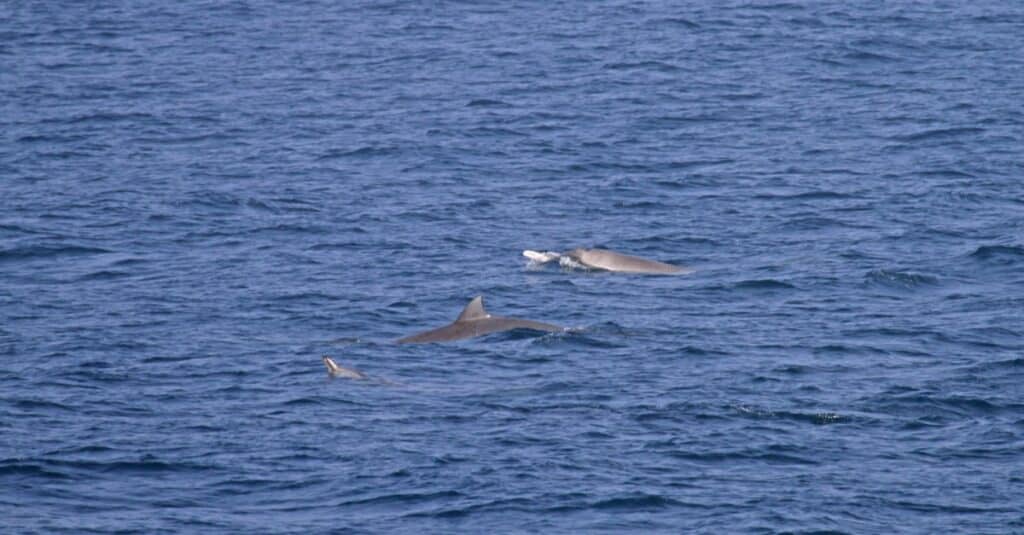
Layard’s beaked whale,
akastrap-toothed beaked whale (
Mesoplodon layardii).
©Agami Photo Agency/Shutterstock.com
Genus Tasmacetus
- Shepherd’s beaked whale (Tasmacetus shepherdi) aka Tasman’s beaked whale or Tasman whale
Genus Ziphius
- Cuvier’s beaked whale (Ziphius cavirostris) aka goose-beaked whale or ziphius

The Cuvier’s beaked whale (
Ziphius cavirostris) can reach depths of nearly 10,000 feet (3 km).
©iStock.com/HeitiPaves
Physeteridae: The Sperm Whale
The Physeteridae superfamily includes the monotypic genus Physeter, which contains the iconic sperm whale (Physeter macrocephalus). Sperm whales are one of the largest toothed whales and the largest toothed predator in the world. Males of the species often grow to 52 feet (16 m) in length and weigh as much as 90,000 pounds (40 metric tons). Sperm whales have a large, square-shaped head that can make up as much as one-third of their body length. They have a single set of teeth in their lower jaw, which fit into corresponding sockets in their upper jaw. Sperm whales are known for their incredibly deep dives, sometimes exceeding 6,500 feet (2,000 m) in depth and lasting over an hour.
Sperm whales are found in all of the world’s oceans, but they are most commonly found in deep offshore waters. These whales have teeth only in their lower jaw, with the number and shape varying depending on the individual. However, they are not typically used for feeding, as sperm whales primarily prey on squid and other deep-sea creatures using suction feeding.
Sperm Whales and Echolocation
Like other toothed whales, sperm whales use echolocation to navigate their environment and locate prey.
Sperm whales are known for their complex vocalizations, including the famous clicks that are thought to be used for echolocation, as well as a variety of other sounds that are thought to be related to communication and social behavior. Besides the melon, sperm whales also have a spermaceti organ in their head that is used to produce sounds for communication and echolocation. Sperm whales are highly social animals that live in groups called pods. Females and young males typically form matrilineal groups, while adult males may live alone or in bachelor groups.
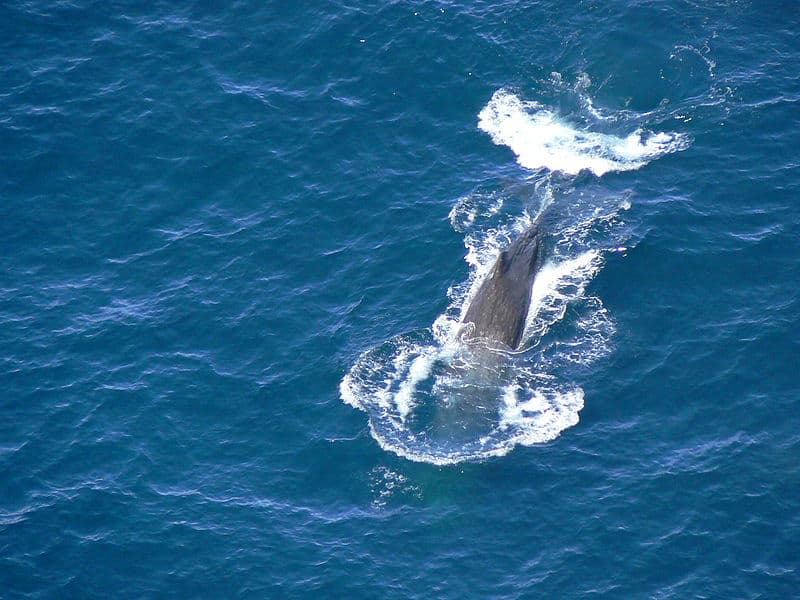
Sperm whales (
Physeter macrocephalus) are the largest toothed predators in the world.
©cianc / Creative Commons – Original
Kogiidae: Pygmy Sperm Whale/Dwarf Sperm Whale
The Kogia genus in the family Kogiidae includes two extant species of small, toothed whales: the pygmy sperm whale (Kogia breviceps) and the dwarf sperm whale (Kogia sima). They have multiple sets of teeth in both their upper and lower jaws. These wee whales are known to be relatively slow swimmers. They are found in tropical and temperate waters around the world. Both species are relatively small compared to other toothed whales. Adults reach lengths of around 8 to 9 feet (2.5 to 3 meters) and weigh less than 600 pounds (272 kilograms). The dwarf and pygmy sperm whales are similar in appearance, with bulbous, spindle-shaped bodies, small dorsal fins, and blunt heads with downturned mouths.
Spermaceti Organ
Like their larger relative, the sperm whale (Physeter macrocephalus), the dwarf and pygmy sperm whales have a spermaceti organ in their head that is used to produce sounds for communication and echolocation. Dwarf and pygmy whales only have teeth (10-16 pair) in the lower jaw which fit into corresponding sockets in their upper jaw. These whales eat small squid and fish, which they capture using suction feeding.
Dwarf and pygmy sperm whales are capable of deep dives, with some individuals diving up to 1,000 feet (300 meters). They are found in warm and temperate waters around the world. Dwarf sperm whales swim in the Atlantic, Indian, and Pacific Oceans. Pygmy sperm whales dive in the Atlantic and Pacific Oceans.
Monodontidae
This Monodontidae family includes two species of toothed whales, the beluga whale (Delphinapterus leucas) and the narwhal (Monodon monoceros). These whales are unique in that they have only a single set of teeth in their upper jaw, and in the case of the narwhal, one of these teeth grows into a long, spiraled tusk. These two species are among the most distinctive and recognizable of all whales and are both adapted to life in the icy waters of the Arctic and sub-Arctic regions. Belugas and narwhals are both social animals that live in groups called pods. These pods may range in size from just a few individuals to several hundred. Both species are also known for their vocalizations, which are used for communication and echolocation. Despite their similarities, however, belugas and narwhals have distinct differences that reflect their unique adaptations to life in Arctic and sub-Arctic regions.
Beluga
Delphinapterus leucas, beluga whales, are known for their distinctive white coloration, which makes them easily recognizable even from a distance. They are relatively small compared to other toothed whales, with adults typically reaching lengths of around 15 feet (4.5 meters) and weighing up to 3,500 pounds (1,600 kilograms). Belugas have a rounded forehead, a stocky body, and a small dorsal fin. They are known for their vocalizations, which include a wide range of whistles, clicks, and other sounds that are used for communication.
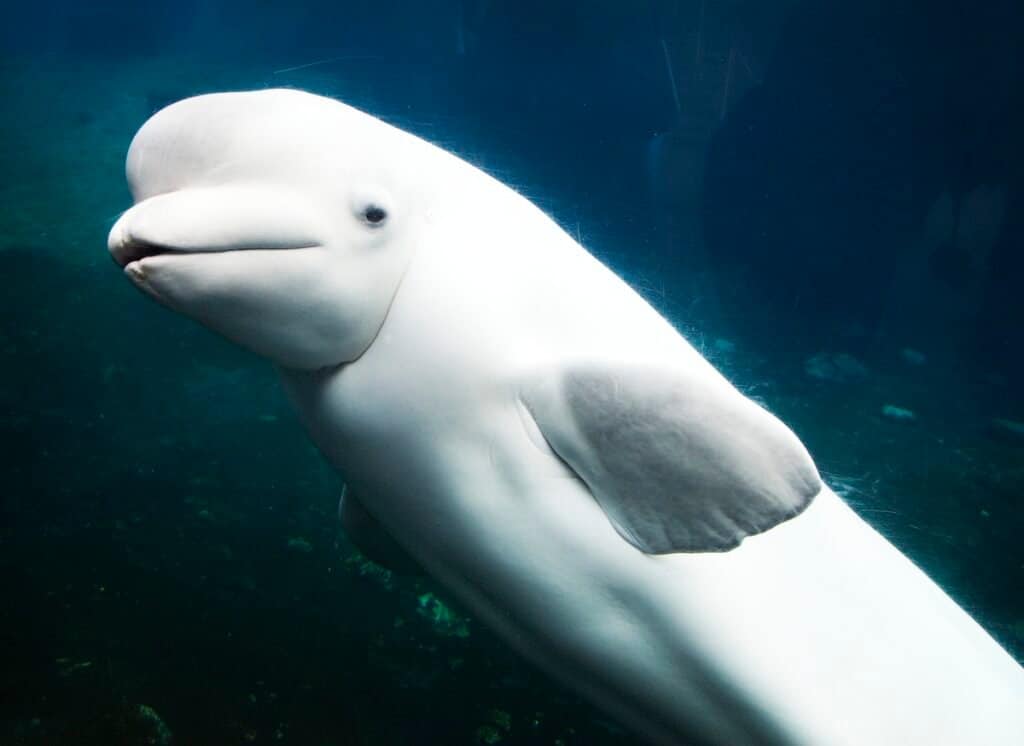
Beluga whales (
Delphinapterus leucas) are known for their distinctive white coloration, which makes them easily recognizable even from a distance.
Narwhal
The narwhal (Monodon monoceros) is best known for its long, spiral tusk, which is actually an elongated canine tooth that can grow up to 10 feet (3 meters) long. The tusk is only found in the male. The purpose of the tusk is not fully understood, although it is thought to play a role in mating displays and fighting between males. Narwhals are also relatively small compared to other toothed whales, with adults typically reaching lengths of 15 to 20 feet (4.5 to 6 meters) and weighing up to 3,500 pounds (1,600 kilograms). They have dark, mottled skin that helps them blend in with their icy surroundings, and a small, rounded dorsal fin.
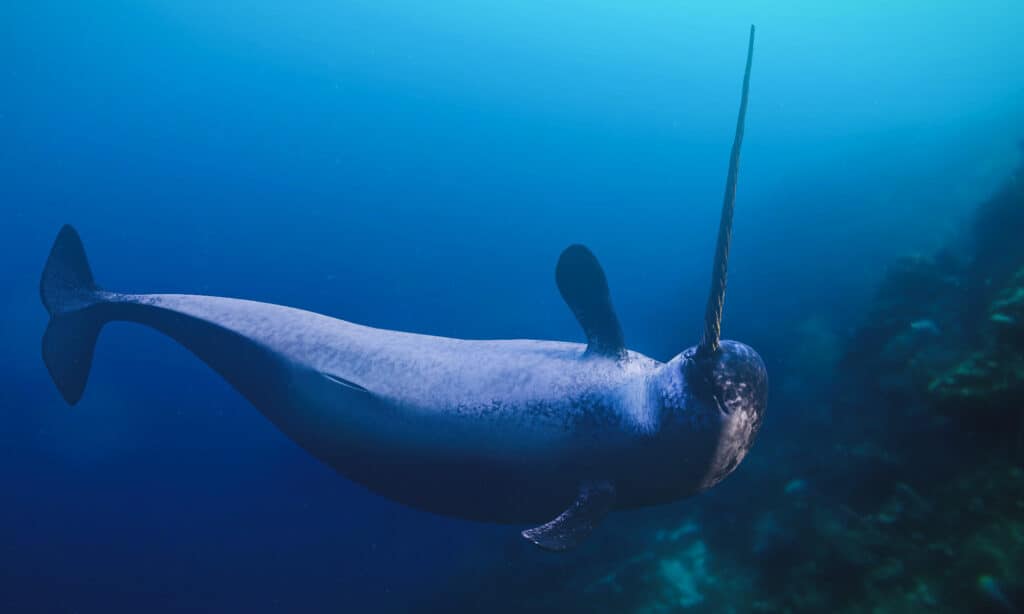
Narwhals (
Monodon monoceros) have dark, mottled skin that helps them blend in with their icy surroundings, and a small, rounded dorsal fin.
©Dotted Yeti/Shutterstock.com
Both belugas and narwhals are adapted to live in cold, icy waters. They have a thick layer of blubber that helps them stay warm in frigid temperatures, and they are able to regulate their body temperature to conserve heat. They are also both able to dive to great depths in search of food, with some individuals recorded diving to depths of more than 4,500 feet (1400m).
Toothed whales are a diverse and fascinating group of marine mammals that are well-adapted to their aquatic environments. From the iconic sperm whale to the enigmatic narwhal, toothed whales have captured the imaginations of people around the world, inspiring awe and wonder.
The photo featured at the top of this post is © Animalgraphy/Shutterstock.com
Thank you for reading! Have some feedback for us? Contact the AZ Animals editorial team.







